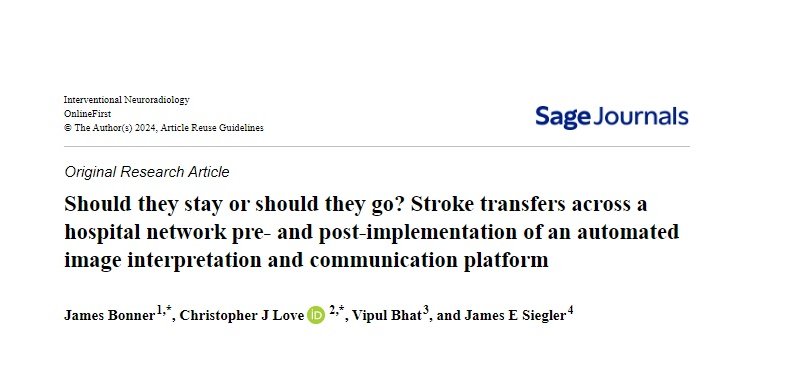
Company: Viz.ai Product: Viz LVO
Should they stay or should they go? Stroke transfers across a hospital network pre- and post-implementation of an automated image interpretation and communication platform
Interventional Neuroradiology, 2024
Abstract
Background
A key decision facing nonthrombectomy capable (spoke) hospitals is whether to transfer a suspected large vessel occlusion (LVO) patient to a comprehensive stroke center (CSC). In a retrospective cohort study, we investigated the rate of transfers resulting in endovascular thrombectomy (EVT) and associated costs before and after implementation of an artificial intelligence (AI)-based software.
Methods
All patients with a final diagnosis of acute ischemic stroke presenting across a five-spoke community hospital network in affiliation with a CSC were included. The Viz LVO (Viz.ai, Inc.) software was implemented across the spokes with image sharing and messaging between providers across sites. In a cohort of patients before (pre-AI, December 2018–October 2020) and after (post-AI, October 2020–August 2022) implementation, we compared the EVT rate among ischemic stroke patients transferred out of our health system to the CSC. Secondary outcomes included the EVT rate based on spoke computed tomography angiography (CTA) and estimated transfer costs.
Results
A total of 3113 consecutive eligible patients (mean age 71 years, 50% female) presented to the spoke hospitals with 162 transfers pre-AI and 127 post-AI. The rate of transfers treated with EVT significantly increased (32.1% pre-AI vs. 45.7% post-AI, p = 0.02). There was a sharp increase in CTA use post-AI at the spoke hospitals for all patients and transfers that likely contributed to the increased EVT transfer rate, but prior spoke CTA use alone was not sufficient to account for all improvement in EVT transfer rate (37.2% pre-AI vs. 49.2% post-AI, p = 0.12). In a binary logistic regression model, the odds of an EVT transfer in the intervention period were 1.85 greater as compared to preintervention (adjusted odds ratio 1.85, 95% confidence interval 1.12–3.06). The decrease in non-EVT transfers resulted in an estimated annual benefit of $206,121 in spoke revenue and $119,921 in payor savings (all US dollars).
Conclusions
The implementation of an automated image interpretation and communication platform was associated with increased CTA use, more transfers treated with EVT, and potential economic benefits.
Read full study